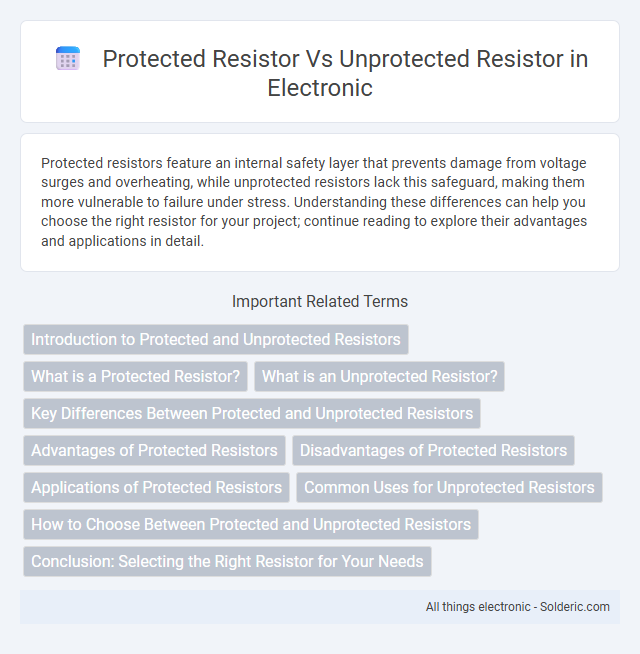Protected resistors feature an internal safety layer that prevents damage from voltage surges and overheating, while unprotected resistors lack this safeguard, making them more vulnerable to failure under stress. Understanding these differences can help you choose the right resistor for your project; continue reading to explore their advantages and applications in detail.
Comparison Table
| Feature | Protected Resistor | Unprotected Resistor |
|---|---|---|
| Definition | Resistor with built-in safeguards against overheating and overload | Basic resistor without extra protection mechanisms |
| Overload Protection | Yes, includes thermal fuse or PTC elements | No, risk of damage or failure under overload |
| Heat Resistance | Higher, designed to withstand elevated temperatures | Lower, may degrade or fail when overheated |
| Cost | Higher due to additional components | Lower, simpler design |
| Reliability | More reliable under fault conditions | Less reliable, prone to failure |
| Typical Applications | Power supplies, safety-critical circuits | Basic electronic circuits, low-risk applications |
Introduction to Protected and Unprotected Resistors
Protected resistors feature built-in safety mechanisms such as fuses or thermal cutoffs to prevent damage from overheating or short circuits, enhancing circuit reliability. Unprotected resistors lack these safeguards, making them vulnerable to failure under excessive current or high temperatures, which can compromise overall system stability. Selecting protected resistors is essential in applications requiring enhanced durability and safety under varying electrical stresses.
What is a Protected Resistor?
A protected resistor is designed with built-in safeguards to prevent damage from excessive current, voltage spikes, or overheating, often incorporating coatings or fuses. It enhances circuit reliability by minimizing failure risks compared to unprotected resistors, which lack these safety features. These resistors are commonly used in sensitive electronics where durability and safety are critical.
What is an Unprotected Resistor?
An unprotected resistor is a basic electrical component that lacks any built-in safeguarding features against overcurrent or overheating. It serves solely to control current flow within a circuit without preventing potential damage from electrical faults. Your choice between unprotected and protected resistors depends on the level of safety and reliability required for your specific application.
Key Differences Between Protected and Unprotected Resistors
Protected resistors include built-in features like thermal fuses or coatings to prevent damage from overheating, while unprotected resistors lack these safeguards, making them more vulnerable to failure under stress. The key differences lie in reliability and safety; protected resistors ensure longer lifespan and reduce risk of fire or circuit damage, whereas unprotected resistors may fail catastrophically when overloaded. Choosing the right resistor for your application depends on whether enhanced durability and safety are priorities.
Advantages of Protected Resistors
Protected resistors offer enhanced durability by incorporating a ceramic casing or epoxy coating that shields the resistor from environmental factors such as moisture, dust, and chemical exposure. This protection significantly improves reliability and longevity in harsh operating conditions, reducing failure rates in circuit applications. Their ability to maintain stable resistance values under mechanical stress and thermal variations ensures consistent performance in precision electronics and industrial systems.
Disadvantages of Protected Resistors
Protected resistors incorporate built-in safety features like fuses or thermal cutoffs that guard against overheating and circuit damage, but they tend to have higher costs and larger physical sizes compared to unprotected resistors. Their added complexity can introduce increased resistance tolerance variability, potentially affecting precision in sensitive electronic applications. You may encounter limited availability and fewer customization options with protected resistors, restricting flexibility in specialized designs.
Applications of Protected Resistors
Protected resistors are ideal for applications requiring enhanced safety and reliability, such as power supplies, automotive circuits, and industrial control systems, where they prevent damage from overcurrent or short circuits. These resistors feature built-in fuses or thermal elements that disconnect the circuit during fault conditions, ensuring the protection of sensitive components and overall system integrity. Your electronic designs benefit from improved durability and reduced maintenance when integrating protected resistors in safety-critical environments.
Common Uses for Unprotected Resistors
Unprotected resistors are commonly used in low-cost, low-risk electronic applications where circuit protection is not critical, such as in basic signal conditioning, simple LED circuits, and general-purpose electronic devices. They are preferred when the primary goal is to control current or voltage without additional safety features like thermal or overcurrent protection. Your choice of an unprotected resistor should consider the operating environment and potential failure risks to ensure component reliability.
How to Choose Between Protected and Unprotected Resistors
Choosing between protected and unprotected resistors depends on your circuit's safety requirements and operating environment. Protected resistors incorporate built-in elements to prevent damage from overloads or faults, enhancing durability and reliability in critical applications. Consider using protected resistors when your design demands higher safety margins or must withstand voltage spikes to safeguard your components and ensure long-term performance.
Conclusion: Selecting the Right Resistor for Your Needs
Choosing the right resistor depends on application requirements for durability and safety; protected resistors offer built-in safeguards against overheating and voltage spikes, enhancing circuit reliability. Unprotected resistors, while often more cost-effective, lack these features and are suited for simpler, low-risk environments. Prioritizing protected resistors in critical or high-stress circuits minimizes failure risk and ensures consistent performance.
protected resistor vs unprotected resistor Infographic

 solderic.com
solderic.com